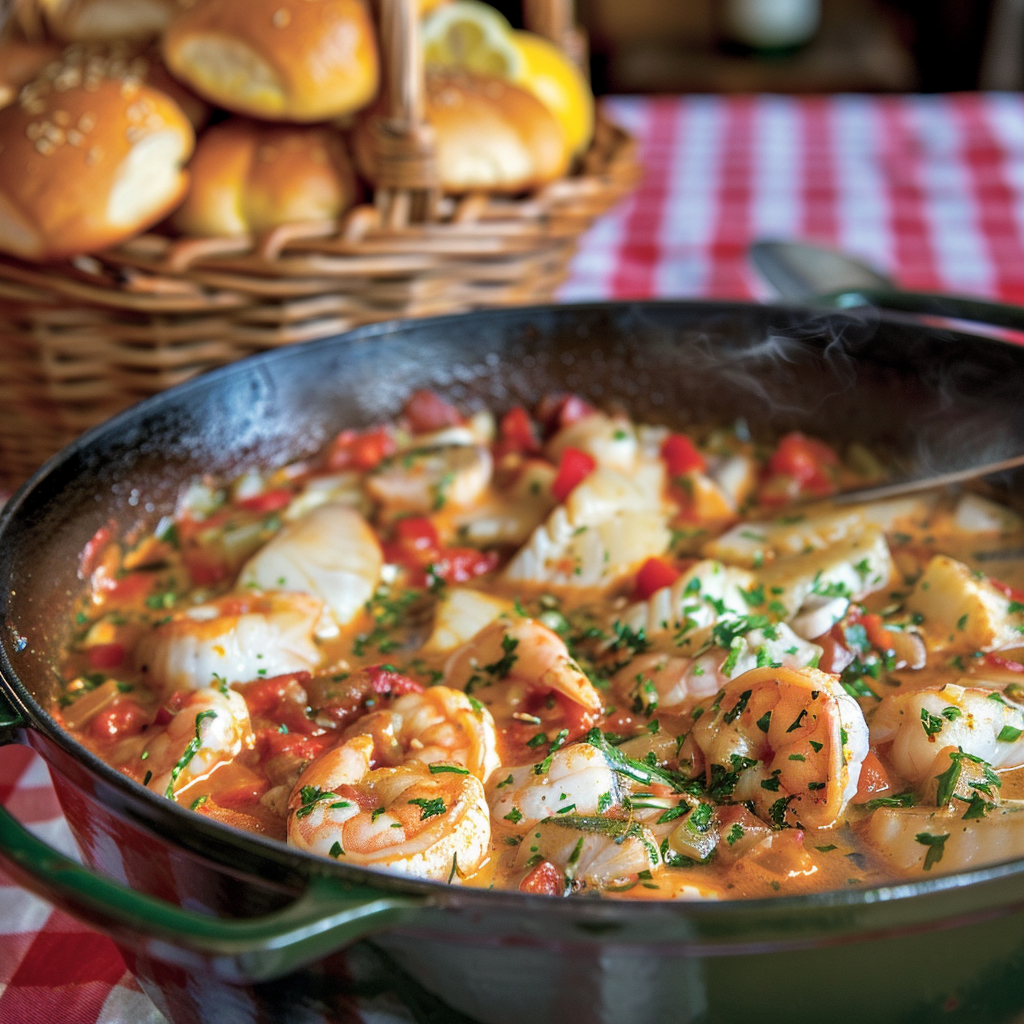Authentic Nova Scotia Fish Stew – A Hearty Seafood Delight

Share
A Memorable Feast in Halifax
Several years ago, my daughter and I took a trip to Halifax, Nova Scotia, where I had the pleasure of experiencing my very first fish stew. We were visiting a dear friend who insisted on introducing us to this local delicacy. There’s no better place to enjoy a fish stew than in a city where the seafood is fresh from the Atlantic Ocean. The stew was rich and full of flavor, a true reflection of the region’s bounty. After the meal, as is typical in Eastern hospitality, we gathered around with musical instruments and sang cheerful songs, enjoying the warmth of friendship and good food. It was a meal I’ll never forget—delicious, a bit on the rich side, but perfect for a special occasion like this one.
Did you know?
Fish stew is a beloved dish in many coastal regions around the world, with each area offering its own unique take on the recipe. Commonly made with a variety of fish and seafood, fish stew is not only delicious but also rich in essential nutrients like omega-3 fatty acids, vitamins, and minerals. Traditional fish stews often include ingredients like tomatoes, onions, garlic, and herbs, which complement the delicate flavor of the fish. Whether enjoyed as a simple family meal or a festive dish, fish stew is a versatile and nutritious option that brings the flavors of the sea to your table.
Yield: 6 servings
Ingredients:
- 1 1/2 pounds firm white fish fillets (such as cod, halibut, or sea bass), cut into bite-sized pieces
- 1/2 pound large shrimp, peeled and deveined
- 2 tablespoons olive oil
- 1 large onion, diced
- 2 cloves garlic, minced
- 1 large bell pepper, diced
- 2 large tomatoes, diced (or 1 can diced tomatoes)
- 4 cups fish stock or vegetable broth
- 1 cup dry white wine (optional)
- 1 teaspoon smoked paprika
- 1/2 teaspoon saffron threads (optional)
- 1 teaspoon dried thyme
- 1 teaspoon dried oregano
- Salt and pepper to taste
- Fresh parsley or cilantro, chopped (for garnish)
- Lemon wedges (for serving)
Instructions:
Prepare the Stew:
In a large pot or Dutch oven, heat the olive oil over medium heat. Add the diced onion and cook until softened, about 5 minutes.
Personal Tip: Stir the onions occasionally to prevent burning and ensure even cooking.
Add the garlic and bell pepper, and cook for another 3 minutes until fragrant and slightly softened.
Personal Tip: If you want a bit of heat, add a pinch of red pepper flakes with the garlic.
Cook the Stew:
Stir in the diced tomatoes (with their juice if using canned), fish stock, white wine (if using), smoked paprika, saffron threads (if using), thyme, oregano, salt, and pepper.
Personal Tip: If you prefer a thicker stew, let the sauce simmer for an extra 10 minutes before adding the seafood.
Bring the mixture to a boil, then reduce the heat to low and let simmer for about 15 minutes to allow the flavors to meld together.
Add the Fish and Shrimp:
Gently add the fish pieces and shrimp to the pot, making sure they are submerged in the broth.
Personal Tip: Avoid stirring too much after adding the seafood to prevent the fish from breaking apart.
Simmer for another 5-7 minutes, or until the fish and shrimp are cooked through and opaque. Be careful not to overcook, as the seafood can become tough.
Serve:
Taste and adjust seasoning if necessary.
Personal Tip: A squeeze of lemon juice just before serving can brighten the flavors of the stew.
Ladle the stew into bowls and garnish with fresh parsley or cilantro.
Serve hot with lemon wedges on the side for a fresh, tangy kick. Enjoy with crusty bread or over rice.
Nutritional Information (Per Serving): Calories: 280, Fat: 10g, Saturated Fat: 1.5g, Carbohydrates: 10g, Fiber: 2g, Sugars: 5g, Protein: 35g
Kitchen Tips, Great Ideas, How to Save Money
-
Bulk Buying: Purchase fish and seafood in bulk or when on sale. Freeze any extra portions for future use. This can significantly reduce the overall cost and ensure you always have ingredients on hand for quick meals.
-
Homemade Fish Stock: Save money by making your own fish stock using fish bones and vegetable scraps. Simmer them in water with herbs and spices, then strain and use in your recipes. This homemade stock can be more flavorful and cost-effective than store-bought versions.
-
Vegetable Variations: This stew is versatile and can accommodate various vegetables based on what you have on hand. Consider adding zucchini, potatoes, or green beans for a different flavor profile.
-
Dairy Alternatives: This recipe is naturally dairy-free, but if you want to add creaminess, consider stirring in a bit of coconut milk or a dollop of dairy-free yogurt before serving.
-
Reusable Storage: Invest in reusable silicone bags or glass containers for storing leftover stew. These are environmentally friendly and can save money over time compared to disposable plastic bags and containers.
-
Energy Efficiency: Cook large batches of the stew and freeze portions for future meals. This saves on energy costs and makes meal prep more efficient. You can reheat the stew on the stovetop or in the microwave for a quick and easy meal.
-
Smart Storage: Store leftover stew in an airtight container in the refrigerator for up to three days. For longer storage, freeze the stew in portioned containers and thaw as needed. This makes for a convenient and nutritious meal option on busy days.
-
Ingredient Substitutions: If you’re out of a particular type of fish, use what you have on hand. Firm white fish, salmon, or even shellfish like mussels can be great substitutes. These alternatives not only save money but also add a unique flavor and extra nutrients to your stew.
-
Learning and Sharing: Engage with online cooking communities for more tips and recipe ideas. Sharing your experiences and learning from others can make cooking more enjoyable and economical. You can discover new techniques, ingredient substitutions, and creative ways to use pantry staples.
-
Flavor Enhancements: Experiment with adding different flavors to your stew, such as a splash of fish sauce or a sprinkle of fresh dill, to add a unique twist to your recipe. Fresh herbs like thyme, rosemary, or dill can also enhance the flavor and add a touch of freshness.
Let's Learn About Different Types of Shrimp
Shrimp come in various types, each offering a unique flavor and texture. From sweet and tender Gulf shrimp to the firm and meaty Tiger shrimp, there’s a variety to suit every dish. Wild-caught shrimp generally have a stronger flavor compared to farmed varieties, making them ideal for rich dishes like this fish stew. When buying shrimp, consider factors like sustainability and the method of catch to ensure you’re making an environmentally friendly choice. Whether you prefer the delicate taste of white shrimp or the robust flavor of brown shrimp, exploring different types can elevate your seafood cooking to new heights.


